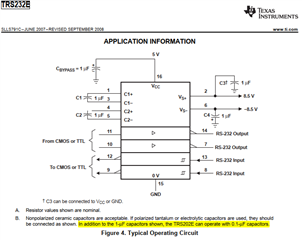Other Parts Discussed in Thread: TRS232E, , TRS202E
Hello TI Experts,
The TRS232E SOIC (D) pkg is in EOL/LTB status, and the recommended replacement part is the MAX232E.
We have some boards in production for many years where the charge pump and supply voltage caps are only 0.1uF instead of the recommended 1uF.
According to the TRS232E datasheet Figure 4, note B, 1uF caps are recommended, but the device can also operate with 0.1uF.
https://www.ti.com/lit/gpn/trs232e

This is not mentioned at all in the MAX232E datasheet, and we're wondering if we should change our BOMs to change to 1uF caps, or if 0.1uF caps would also work with the MAX232E?
I had asked a related question when we replaced the obsolete LMS202ECM/NOPB with the TRS232E and was told the ratio of capacitors was more important than the absolute value of the caps.
Does this reasoning also apply for the MAX232E, even though using 0.1uF caps is not mentioned in the MAX232E datasheet?
We will order some samples for validation, but we just wanted to hear what TI might have to say.
Thanks,
USO


